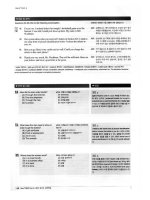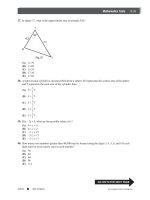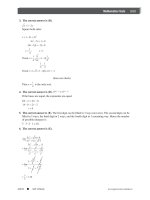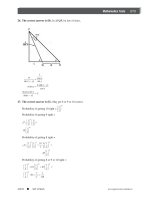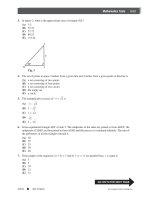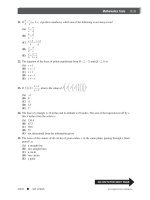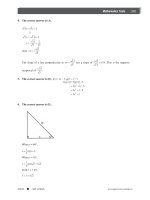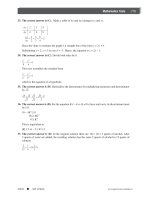SAT II Biology Episode 2 Part 1 pdf
Bạn đang xem bản rút gọn của tài liệu. Xem và tải ngay bản đầy đủ của tài liệu tại đây (793.31 KB, 20 trang )
The metabolism of proteins, for example, produces toxic
substances harmful to body tissues and must be gotten rid of. It is
important to distinguish between the elimination that is achieved in
the digestive system and the excretion done in this system. Material
that passes entirely through the system is finally eliminated from the
body as a passive act. What ends up in the lower large intestine is
material that is left over after all the other nutrients have been acted
on. It is not gathered and deposited there as an active process of
excretion performed on materials, such as proteins and carbohy-
drates; it just happens to end up there. On the other hand, excretion
is a homeostatic event with several systems working in concert to
actively gather the substances necessary to maintain homeostasis and
excrete those harmful substances from the body. The metabolism of
proteins produces nitrogen wastes, most predominantly ammonia.
This is coupled with carbon dioxide in the liver and is “neutralized,”
or made less harmful, in the form of urea.
Transported to the kidneys, blood is filtered out in units called
nephrons that house the main filtering structure, Bowman’s capsule
and tubules. In the nephrons, substances needed by the body are
reabsorbed into the vascular system. Substances not needed by the
ANIMALS—STRUCTURE AND FUNCTION
177
Peterson’s n SAT II
Success: Biology E/M www.petersons.com
body are excreted. Mediated by hormones and other chemical factors,
the resulting mix that has been selectively separated is passed to the
bladder through the ureters, where it is stored until it will be
excreted from the body through the urethra.
COMPARATIVE
Unicellular organisms simply pass their nitrogenous wastes through
their plasma membrane by diffusion and maintain water balance by
osmosis. Annelids filter and collect these wastes in nephridia that
connect to the outside environment. Arthropods collect nitrogenous
wastes in structures called Malpighian tubules and then pass the
wastes to the environment. Aquatic organisms, for the most part,
excrete ammonia directly into the water, and birds produce uric acid,
a largely insoluble substance that precipitates in their systems, which
they then excrete.
NERVOUS SYSTEM (NS)
HUMAN
The basic unit of the nervous system is the neuron. Three principal
neurons are the sensory (afferent—move information toward central
nervous system), motor (efferent—move information away from
central nervous system), and interneuron (association), which,
respectively, receive signals, activate muscles, and connect the two
and make up the neurons found in the spinal cord and brain.
CHAPTER 7
178
Peterson’s n SAT II
Success: Biology E/Mwww.petersons.com
Nerve cell axons are covered by a protective sheath called the
myelin sheath, which is also where the segments of sheath connect
exposed areas known as the Nodes of Ranvier’s. Communication
within the nervous system proceeds by way of an electrochemical
event called a nerve impulse. As the nerve impulse proceeds along
the nerve, an action potential is created by the interaction between
ions inside and outside, the result of which is an electrical impulse.
When the nerve impulse reaches the gap between two nerve cells,
called the synapse, a neurotransmitter manufactured in sacs or
vesicles at the end of a one-nerve ending is dumped into the synapse,
which causes the next nerve to “fire.” One of the neurotransmitters,
acetylcholine, is then broken down almost immediately—lest the next
nerve keep firing without an impulse from the preceding nerve—by
an enzyme called acetycholinesterase.
ANIMALS—STRUCTURE AND FUNCTION
179
Peterson’s n SAT II
Success: Biology E/M www.petersons.com
The central nervous system (CNS) is composed of the brain and
the spinal cord. The main parts of the brain are the cerebrum (the
largest), which controls all voluntary action and interprets sensory
information; the cerebellum, or “little cerebrum,” which coordinates
muscle activity; the hypothalamus, which regulates homeostasis and
secretes hormones; the pituitary, part of the hypothalamus, which is
the “master” controlling gland of the body that controls hormone
activity; and the medulla, which controls involuntary actions.
The peripheral nervous system (PNS) connects the CNS with all
the outlying organs from the brain, skin, and all blood vessels. It is
CHAPTER 7
180
Peterson’s n SAT II
Success: Biology E/Mwww.petersons.com
broken down into the somatic functions or voluntary functions and
the autonomic functions or involuntary ones. The autonomic nervous
system is further broken down into the sympathetic and parasympa-
thetic portions of this system. The former prepares the body for
action and the latter brings the body back to homeostasis. Finally, a
rapid response, which initially goes from sensory neuron to an
association neuron in the spinal cord and directly to a motor neuron,
is called a reflex arc. Eventually—milliseconds later—the information
reaches the brain.
COMPARATIVE
Single-celled organisms act mostly by moving away from irritants and
toward attractants. Food attracts them, and toxins irritate them. Some
even move according to the amount of light, but they possess no
nerve structures. Coelenterates have a simple internal nerve net that
covers their body. Annelids have a rudimentary nervous system
consisting of a group of nerve cells called a ganglion and a nerve net
that is the length of their body. This makes them capable of sensing
their environment, but on a very primitive level, much like the
protists. Arthropods, similarly, have a rudimentary system that is
different in some structures from the annelids but similar in the
resulting action. They have several specialized organs, such as eyes.
ANIMALS—STRUCTURE AND FUNCTION
181
Peterson’s n SAT II
Success: Biology E/M www.petersons.com
SKELETAL SYSTEM
HUMANS
Humans have an endoskeleton made of hard tissue called bones.
Bones act to support, protect, make blood cells, store minerals, and
aid—along with the muscle system—in movement. Students should
be familiar with the process of ossification, Haversian canals, and the
spongy and hard bony areas of a typical bone.
The skeleton, consisting of 206 bones, has two main divisions;
the axial skeleton and the appendicular skeleton. The axial skeleton
has 80 bones located in the skull, the vertebral column, and the rib
cage. The appendicular skeleton consists of the arms, legs, and pelvic
and pectoral girdles.
CHAPTER 7
182
Peterson’s n SAT II
Success: Biology E/Mwww.petersons.com
The place where bones meet is called a joint or suture, and
humans have joints described by names that suggest their action,
such as pivot, gliding, saddle, hinge, ball-and-socket, and even fixed
joints.
Bones are held in place by ligaments that, in concert with
muscles, help maintain the structural integrity of the body under
normal conditions.
ANIMALS—STRUCTURE AND FUNCTION
183
Peterson’s n SAT II
Success: Biology E/M www.petersons.com
In between many joints is a smooth, cushioning material called
cartilage; some other body structures are composed of cartilage, such
as the nose and the outer ear.
COMPARATIVE
Protists, coelenterates, and annelids have no skeletal structures but
possess a hydrostatic skeleton (support comes from internal water
pressure), and arthropods have an exoskeleton made of chitin.
Echinoderms, contrary to what you might think, have an endoskel-
eton composed of ossicles.
MUSCULAR SYSTEM
HUMAN
Humans have muscle tissue that is capable of contracting and
relaxing. Skeletal muscle tissue is composed of elongated cells called
muscle fibers.
CHAPTER 7
184
Peterson’s n SAT II
Success: Biology E/Mwww.petersons.com
The primary function of this tissue is to aid in movement.
Striated muscle, known also as skeletal or voluntary muscle, aids in
moving the body along with the help of the skeleton—thus the name
skeletal. Skeletal muscles are capable of very fast action, although
they fatigue over a relatively short time. They are attached to the
skeleton in opposing pairs: when one contracts, the opposite
“partner” relaxes, and vice versa. Humans also have a muscle type,
known as smooth muscles that comprise internal organs and blood
vessels capable of much slower action but that rarely fatigue. The
third type of muscle that humans have is exclusively in the heart and
is therefore called cardiac muscle. In cardiac muscle, we find a
combination of striated and smooth muscle tissue all in one. The best
of both of these two worlds then is achieved in cardiac muscle,
which acts fast and does not fatigue under normal conditions.
Muscles are attached to the bones of the skeletal system by connec-
tive tissue extensions of the muscles called tendons.
COMPARATIVE
Protists do not have muscles but are capable of changing the shape of
the plasma membrane to achieve a variety of movements. Coelenter-
ates have a simple network of tissue that can contract. Annelids have
simple muscle tissue that can provide them with more directed
movement—one set of muscle tissue rings their body, and another set
runs the length of it. Arthropods, with their exoskeleton, have
muscles internal to that skeleton, which means that those muscles
ANIMALS—STRUCTURE AND FUNCTION
185
Peterson’s n SAT II
Success: Biology E/M www.petersons.com
work in an opposite fashion to human muscles, as the “lever” system
is opposite to that of humans.
ENDOCRINE SYSTEM
HUMAN
The other system in humans that acts to control the internal environ-
ment is the endocrine system. Composed of a series of ductless
glands—they use the blood vessels as their tubes—these glands
secrete a class of chemicals known as hormones. These chemicals
have specific effects on specific tissues, known as target tissues, in
the body. Once again, as in the nervous system, the basic need is to
maintain a steady state or homeostasis. The so-called master gland
that releases many hormones that affect other endocrine glands as
well as significant areas of the body—bones and muscles in mediating
growth—is the pituitary gland. The anterior pituitary secretes no less
than six hormones that control growth (GH), the adrenal cortex
(ACTH), the thyroid (TSH), the ovaries (FSH and LH), and production
of milk (Prolactin). The posterior pituitary stores another two
hormones, called vasopressin, that control the balance of water in the
body and oxytocin, a key hormone in parturition. A list of the glands
and what they control is offered in the following chart:
N
G
M
s
s
CHAPTER 7
186
Peterson’s n SAT II
Success: Biology E/Mwww.petersons.com
REPRODUCTIVE SYSTEM
HUMAN
The system given to the process of continuing the species is, of
course, the reproductive system, and students should be conversant
with where the events take place in both male and female, when
they take place, and under the influence of what hormones.
You should understand both the male and the female parts and
their functions. In addition, students are tested on critical events,
such as gastrulation, blastulation, and general morphogenesis of the
embryo to fetus.
Females manufacture an ova in a structure called the ovaries.
The cyclic secretions of hormones normally causes the release of one
egg approximately every month. Generally, the process, called
menses, is started with the production of an egg under the influence
of FSH. The follicle, in turn, produces estrogen that triggers an
ANIMALS—STRUCTURE AND FUNCTION
187
Peterson’s n SAT II
Success: Biology E/M www.petersons.com
increase in LH from the pituitary, turning the follicle into a body
known as a corpus luteum, which continues to produce estrogen and
a new hormone called progesterone. Progesterone readies the body
for pregnancy by mainly increasing the number of blood vessels in
the uterus. As the follicle ruptures under the influence of LH, it
releases the egg in a process called ovulation. If the egg is not
fertilized, the corpus luteum eventually shuts down, and the unfertil-
ized egg, along with the now unnecessary, newly manufactured blood
tissues in the uterus, are sloughed off and exit the body. This signals
menstruation, and the process begins all over again as the level of
FSH rises in the other ovary. Thus the cycle repeats.
If the egg is fertilized, the embryo itself produces a hormone
that continues the LH hormone to be secreted and suppresses FSH
until birth. The fertilized egg or zygote goes through the developmen-
tal stages of the blastula and gastrula during which three germ layers
develop. The ectoderm will develop into the epidermis and nervous
system, the mesoderm develops in the most other systems, while the
endoderm will form the lining of the digestive, respiratory tracts, and
urinary bladder.
In addition to the development of the embryo, the organism
undergoes growth differentiation and morphogenesis.
CHAPTER 7
188
Peterson’s n SAT II
Success: Biology E/Mwww.petersons.com
At the age of three months, it is referred to as the fetus until the
birth process or parturition is initiated.
Human males produce sperm in a process described in Chapter
4 on meiosis. This process is not cyclic but continual and is initiated
and maintained by the hormone testosterone.
COMPARATIVE
Heterotrophs can reproduce asexually, which several phyla are
capable of, but most can reproduce sexually, too.
ANIMALS—STRUCTURE AND FUNCTION
189
Peterson’s n SAT II
Success: Biology E/M www.petersons.com
MULTIPLE-CHOICE QUESTIONS
1. Which of the following is the specialized absorptive structure in
the intestine?
(A) alveoli
(B) villi
(C) Bowman’s capsule
(D) salivary glands
(E) pyloric sphincter
2. Which of the following tissues contains the highest number of
mitochondria?
(A) nervous
(B) skin
(C) connective
(D) muscle
(E) bone
3. Select the correct sequence for human circulation.
(A) heart—vein—capillary—artery—heart
(B) heart—artery—lung—vein—body systems—heart
(C) heart—artery—lungs—vein—heart—body systems
(D) body system—lungs—heart—vein—capillary—artery
(E) heart—artery—lungs—body systems—vein—heart
4. The skeletal system does all of the following EXCEPT
(A) support.
(B) transport.
(C) protect.
(D) digest.
(E) store.
5. Endocrine glands
(A) secrete vitamins.
(B) cease functioning after adolescence.
(C) begin functioning in adolescence.
(D) have ducts.
(E) have no ducts.
CHAPTER 7
190
Peterson’s n SAT II
Success: Biology E/Mwww.petersons.com
6. Bile
(A) activates pancreatic lipases.
(B) emulsifies fat droplets.
(C) congeals fat droplets.
(D) digests fats.
(E) is produced in the pancreas.
7. Which of the following enzymes acts on protein?
(A) pepsin
(B) ptyalin
(C) amylase
(D) maltase
(E) sucrase
8. Digestion in protozoans is
(A) extracellular.
(B) intracellular.
(C) intercellular.
(D) dorsal.
(E) none of the above.
9. Which of the following is true about the blood?
(A) Arteries carry oxygen-rich blood.
(B) Arteries carry oxygen-poor blood.
(C) Veins carry oxygen-rich blood.
(D) Veins carry oxygen-poor blood.
(E) None of the above is true.
10. Chemical digestion begins in the
(A) mouth.
(B) esophagus.
(C) stomach.
(D) gall bladder.
(E) small intestine.
EXPLANATION OF ANSWERS FOR MULTIPLE-CHOICE QUESTIONS
1. The correct answer is (B). The alveoli are structures that allow
the passage, not absorption, of carbon dioxide and oxygen into
the lungs. Bowman’s capsule is where the filtration of the blood
occurs in the nephrons of the kidney. Salivary glands produce
ANIMALS—STRUCTURE AND FUNCTION
191
Peterson’s n SAT II
Success: Biology E/M www.petersons.com
amylase that helps begin the breakdown of carbohydrates in the
mouth, and the pyloric sphincter is the valve-like structure at the
end of the stomach that allows the passage of chyme. The villi
are specialized, finger-shaped structures in the lower intestine
that are designed for absorption of digested nutrients.
2. The correct answer is (D). One would expect that the cells
with the highest potential for activity would have the highest
number of mitochondria, the powerhouse of the cell, which
would be muscles, choice (D). Connective tissue has very little
need for such a high level of activity, and bone cells reach the
point of utility as fairly sanguine cells. The only choice that
comes close to muscles would be nerve cells, but, while they
may achieve a high level of activity from time to time, they
certainly do not need to fire nearly as often as muscle cells. In
addition, muscle cells need the energy when they contract and
to reconstruct the actin and myosin complexes when they relax
to be ready to function again.
3. The correct answer is (C). While presented with a veritable
hodgepodge of choices here—which just may occur on the
exam—the only one that makes sense is choice (C), where the
blood leaves the heart through an artery—Arteries Away—to the
lungs, back to the heart through a vein, and from the heart, out
to the body systems. Choice (A) looks good on the surface,
except a vein is leaving the heart, not an artery. In choice (B),
once the blood goes to the lungs, it goes right to the body
systems, which erroneously bypasses the heart. Choice (D) also
bypasses the heart as the blood returns from the body systems,
and choice (E), like choice (B), bypasses the heart.
4. The correct answer is (D). The skeletal system does not digest
anything for the body. It stores minerals, such as calcium and
phosphorous; it supports the body mass and also helps with
transport of the body in concert with the muscles; and its cells
reproduce and make more bone cells.
5. The corrrect answer is (E). It is important to define endocrine
glands as ductless—they offer a separate delivery system from
gland to target area. The endocrine glands use the “ducts” of the
circulatory system, also known as blood vessels. The exocrine
glands, such as the salivary glands and the pancreas, have ducts.
The endocrine glands begin functioning at parturition and
continue to function throughout life. Finally, endocrine glands do
not secrete vitamins.
6. The correct answer is (B). Bile is produced in the liver, and its
main function is to emulsify fat droplets into smaller fat droplets,
contrary to congealing—which it does not do. Congealing is the
CHAPTER 7
192
Peterson’s n SAT II
Success: Biology E/Mwww.petersons.com
gathering of small droplets into bigger ones. Pancreatic lipases
come in an activated form, and bile certainly does not digest fats;
it emulsifies them.
7. The correct choice is (A). Choices (B) through (E) represent
enzymes that act on carbohydrates, ptyalin being another name
for amylase. Maltase and sucrase, as their names suggest, are
enzymes that act, respectively, on maltose and sucrose. Choice
(A) is a protease that arises from a precursor, pepsinogen, that is
activated by hydrochloric acid, which is the acid found in gastric
juices.
8. The correct answer is (B). Unicellular protists take their food
into the cell that is the entire organism and digest it entirely
intracellularly. Humans, for example, digest their nutrients
extracellularly and absorb them into cells only after they are
digested. Since protists are unicellular, the suggestion of intercel-
lular digestion is meaningless. The reference to dorsal is a certain
orientation or place on multicellular organisms.
9. The correct answer is (E). A favorite trap of the test makers is
to determine how solid the students are in their knowledge of
the circulatory system by presenting questions that suggest that
the movement of blood through the various vessels is wholesale.
For example, they may suggest that arteries always carry oxygen-
ated blood. While the bulk of blood carried in arteries is oxygen-
ated, the blood in the pulmonary arteries is oxygen-poor—thus
the reason for the trip to the lungs. Likewise, one can make a
confusing statement about veins, but it would also be false. Veins
that carry the blood back to the heart from the lungs are the
only ones that carry oxygen-rich blood.
10. The correct answer is (A). Chemical digestion in humans can
begin as soon as a nutrient enters the mouth, of course, if it has
carbohydrate in it. So no matter what the nutrient is, it could
begin in the mouth. The stomach is the second place that
chemical digestion occurs when proteins are acted upon by
pepsin. The esophagus is a tube that connects the pharynx with
the stomach, so no digestion occurs there. No digestion takes
place in the gall bladder—it is just a storage place for bile—and
the small intestine is too general an answer. Digestion takes place
in the upper portion of the small intestine and absorption takes
placer in the lower portion. It doesn’t matter, actually, since the
question asks where digestion begins.
ANIMALS—STRUCTURE AND FUNCTION
193
Peterson’s n SAT II
Success: Biology E/M www.petersons.com
VOCABULARY
acetylcholine
acetylcholinesterase
ACTH
action potential
adrenal cortex
adrenal medulla
AIDS
alveolus
ammonia
amnion
antibody
antigen
anus
aorta
aortic valve
arterioles
artery
autonomic nervous system
axons
bile
bladder
blastula
B-lymphocytes
bolus
bone
Bowman’s capsule
bronchi
bronchioles
capillaries
cardiac muscle
cartilage
cell body
cerebellum
cerebrum
chorion
chyme
cleavage
CNS
collagen
collecting duct
corpus luteum
dendrites
deoxygenated
dermis
digestion
emulsify
endocrine
epidermis
epiglottis
epinephrine
erythrocytes
esophagus
estrogen
expiration
fallopian tube
feces
feedback
fertilization
fetus
filtrate
FSH
gastrula
glomerulus
glucagon
glycogen
growth hormone
homeostasis
hormones
hyperthyroidism
hypothalamus
hypothyroidism
immune
inferior vena cava
inspiration
insulin
integument
interneurons
involuntary muscles
islet of Langerhans
joints
kidney
large intestine
larynx
left atrium
left ventricle
leukocytes
CHAPTER 7
194
Peterson’s n SAT II
Success: Biology E/Mwww.petersons.com
LH
ligaments
loop of henle
lungs
lymph
lymphocytes
marrow
mastication
medulla
menstruation
morphogenesis
motor neurons
mouth
myelin
nephridia
nephrons
neurons
neurotransmitter
notochord
ova
ovaries
oviduct
ovulation
oxygenated
pancreas
parathyroids
pepsin
peristalsis
pharynx
pituitary
plasma
platelets
PNS
polarized
progesterone
puberty
pulmonary
pyloris
reabsorb
rectum
renal
right atrium
right ventricle
saliva
Schwann cells
secretion
sensory neurons
sinuses
skin
small intestine
sodium-potassium pump
sperm
steroid
striated
subcutaneous
superior vena cava
sympathetic nervous system
synapse
systemic circulation
tendons
testosterone
T-helper cells
thyroid
thyroxin
T-killer cells
T-lymphocytes
trachea
trypsin
urea
ureters
urethra
uterine walls
uterus
vasopressin
veins
venules
villi
vitamin K
voluntary muscles
yolk sac
zygote
ANIMALS—STRUCTURE AND FUNCTION
195
Peterson’s n SAT II
Success: Biology E/M www.petersons.com
